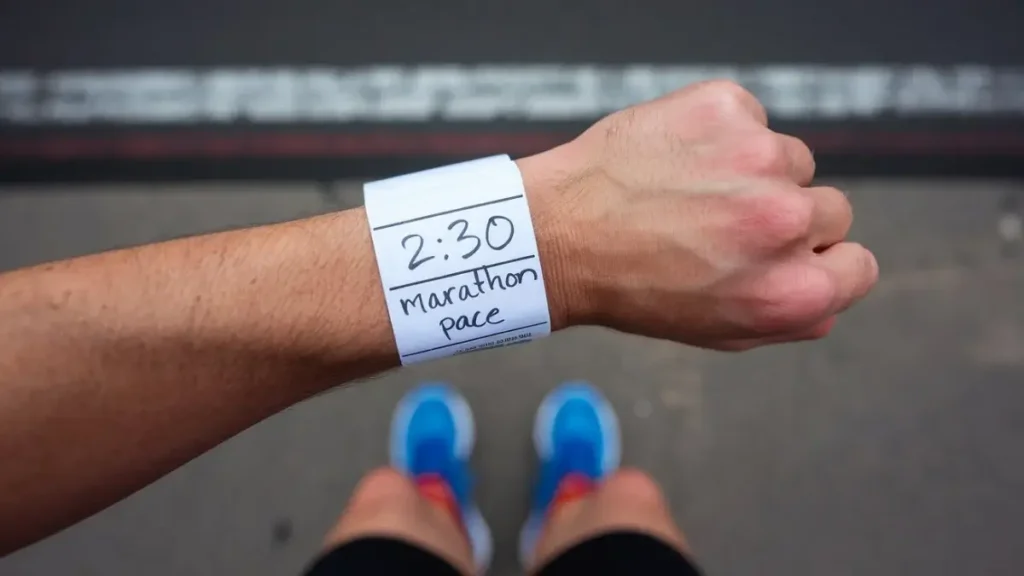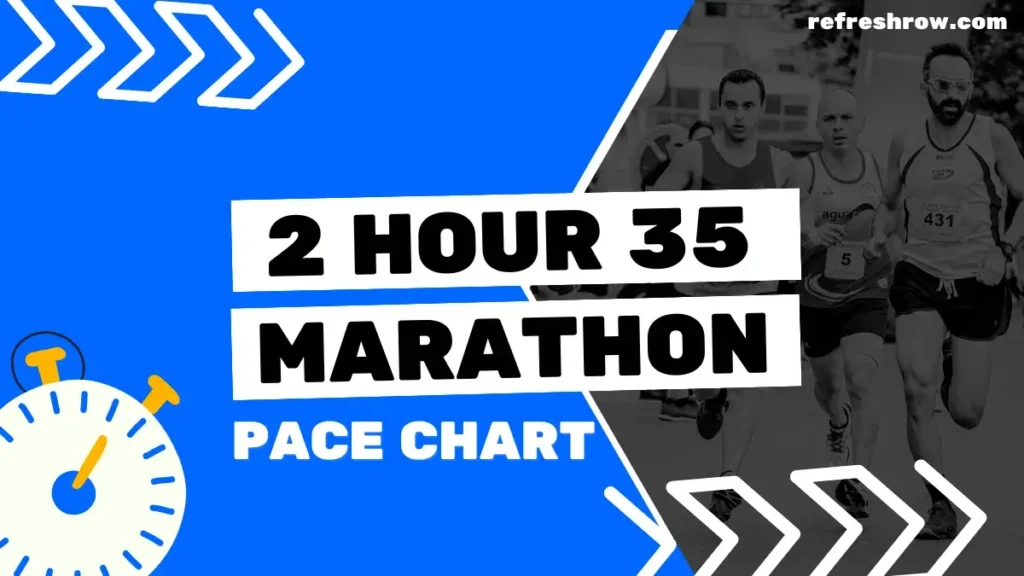To run a 4:40 hour marathon you need to run at a pace of 10:41 per mile or 6:38 per kilometer.
Following the splits below (and shaving off a second), you’ll run a sub 4:40 marathon.
I’d recommend aiming to run 1-2 minutes ahead of the split target time from 10 miles, as you’ll likely come up against crowding on race day.
4:40 Marathon Pace in Miles
| Mile | Split |
|---|---|
| 1 | 10:41 |
| 2 | 21:22 |
| 3 | 32:02 |
| 4 | 42:43 |
| 5 | 53:24 |
| 6 | 1:04:05 |
| 7 | 1:14:45 |
| 8 | 1:25:26 |
| 9 | 1:36:07 |
| 10 | 1:46:48 |
| 11 | 1:57:28 |
| 12 | 2:08:09 |
| 13 | 2:18:50 |
| 14 | 2:29:31 |
| 15 | 2:40:11 |
| 16 | 2:50:52 |
| 17 | 3:01:33 |
| 18 | 3:12:14 |
| 19 | 3:22:54 |
| 20 | 3:33:35 |
| 21 | 3:44:16 |
| 22 | 3:54:57 |
| 23 | 4:05:38 |
| 24 | 4:16:18 |
| 25 | 4:26:59 |
| 26 | 4:37:40 |
| 26.2 | 4:40:00 |
Download
4:40 Marathon Pace in KM
| KM | Split |
|---|---|
| 1 | 6:38 |
| 2 | 13:16 |
| 3 | 19:54 |
| 4 | 26:33 |
| 5 | 33:11 |
| 6 | 39:49 |
| 7 | 46:27 |
| 8 | 53:05 |
| 9 | 59:43 |
| 10 | 1:06:22 |
| 11 | 1:13:00 |
| 12 | 1:19:38 |
| 13 | 1:26:16 |
| 14 | 1:32:54 |
| 15 | 1:39:32 |
| 16 | 1:46:10 |
| 17 | 1:52:49 |
| 18 | 1:59:27 |
| 19 | 2:06:05 |
| 20 | 2:12:43 |
| 21 | 2:19:21 |
| 22 | 2:25:59 |
| 23 | 2:32:37 |
| 24 | 2:39:16 |
| 25 | 2:45:54 |
| 26 | 2:52:32 |
| 27 | 2:59:10 |
| 28 | 3:05:48 |
| 29 | 3:12:26 |
| 30 | 3:19:05 |
| 31 | 3:25:43 |
| 32 | 3:32:21 |
| 33 | 3:38:59 |
| 34 | 3:45:37 |
| 35 | 3:52:15 |
| 36 | 3:58:53 |
| 37 | 4:05:32 |
| 38 | 4:12:10 |
| 39 | 4:18:48 |
| 40 | 4:25:26 |
| 41 | 4:32:04 |
| 42 | 4:38:42 |
| 42.2 | 4:40:00 |
Download
Other Marathon Pace Charts
Targeting a different time?
Check out the Full Marathon Pace Chart in Miles or KM
Or select a specific finishing time below:
| 3:00 | 4:00 | 5:00 | |
| 3:05 | 4:05 | 5:15 | |
| 3:10 | 4:10 | 5:30 | |
| 3:15 | 4:15 | 5:45 | |
| 3:20 | 4:20 | 6:00 | |
| 3:25 | 4:25 | 6:15 | |
| 2:30 | 3:30 | 4:30 | 6:30 |
| 2:35 | 3:35 | 4:35 | 6:45 |
| 2:40 | 3:40 | 4:40 | 7:00 |
| 2:45 | 3:45 | 4:45 | |
| 2:50 | 3:50 | 4:50 | |
| 2:55 | 3:55 | 4:55 |
Training for a 4:40 Marathon
Is 4:40 a Good Marathon Time?
Well, what do the stats say?
Run Repeat conducted a study that contains 19,614,975 marathon results from more than 32,335 races across the globe, here is how a 4:40 marathon compares against age and gender for the races recorded:
| Overall | You’re faster than 38.8% of all runners. |
| Male | You’re faster than 28.9% of males. |
| Female | You’re faster than 52.0% of females. |
| <20 | You’re faster than 38.1% of under 20s. |
| 20-29 | You’re faster than 31.3% of 20-29 year olds. |
| 30-39 | You’re faster than 31.2% of 30-39 year olds. |
| 40-49 | You’re faster than 35.7% of 40-49 year olds. |
| 50-59 | You’re faster than 48.3% of 50-59 year olds. |
| >60 | You’re faster than 69.7% of over 60s. |
Training Runs and Paces for a 4:40 Marathon
To break a 4:40 marathon you’ll need to do some serious distance in your training, I recommend at least 15 miles (24km) per week.
You’re also going to need to make sure you’ve crossed off these milestones for other race distances:
- A 5k in 28:55 mins
- A 10k in 1 hour 50 secs
- A half marathon in 2 hours 8 mins
Training Paces
| Pace | Mins per Mile | Mins per KM |
|---|---|---|
| Easy | 12:02 | 7:28 |
| Steady | 10:41 | 6:38 |
| 10k | 9:47 | 6:05 |
| 5k | 9:23 | 5:50 |
| 1 Mile | 8:43 | 5:27 |
Weekly Mileage Targets
| Target Mileage: | Gradually increase your weekly mileage from 18 miles (29 km) to a peak of 28 miles (45 km). |
| Incremental Increase: | Increase mileage by approximately 10% each week, with every fourth week as a recovery week where mileage is reduced by 20-30%. Make sure to taper for the last 1-2 weeks. |
Long Run Structure
| Total Distance: | Build up to long runs of 18-20 miles (29-32 km). |
| Segment Example: | First 5 miles (8 km): Easy pace, heart rate 140-150 bpm (approximately 13:00/mile or 8:04/km). Next 1 mile (1.6 km): Fast pace at 9:10/mile (5:41/km). Next 5 miles (8 km): Medium effort, heart rate around 160 bpm (approximately 10:10/mile or 6:18/km). Repeat: Repeat the segment twice (5 miles easy, 1 mile fast, 5 miles medium), you can taper the final 2 miles if required. |
Why This Works: Incorporating varied paces within long runs enhances lactate tolerance, which helps on race day when you’ve got to maintain pace despite feeling fatigued. By practicing surges during a run, you can build up your physical and mental resilience (lots of elite marathon runners use these strategies during their training)
Alternating Long Runs: Alternate between structured long runs (easy/fast segments) and easier long runs. For easier long runs, maintain a steady, comfortable pace throughout, focusing on mileage rather than speed to aid recovery.
Speedwork Sessions
| Short Intervals: | – 800m repeats at 4:35 per interval (5:43/km). – Aim for 5-7 repetitions with equal time for recovery. |
| Mile Repeats: | – 1 mile repeats at 9:10 per mile (5:41/km). – Aim for 4-6 repetitions with a 1-2 minute recovery jog. |
| Longer Intervals: | – 2 mile repeats at 9:20 per mile (5:48/km). – Aim for 3-4 repetitions with a 2-3 minute recovery jog. |
Recovery and Rest Days
| Rest Days: | You don’t need to incorporate rest days if you are using recovery runs, but I recommend taking 1 (or a max of 2) per week to allow your body to recover and prevent overtraining. |
| Easy Run Days: | Include 1-2 easy run days per week at a relaxed pace of 13:15/mile (8:14/km), covering 3-5 miles (5-8 km) per day. Try to keep your heart rate below 140 bpm on easy days to ensure proper recovery and aerobic development. |
My Tips to Run a Sub 4:40 Marathon
Practice Running on Tired Legs
For your marathon, I’m sorry, but fatigue is inevitable, so training your body to handle running on tired legs is crucial.
I used to incorporate “back-to-back” long runs into my schedule.
For example, I’d do an 8-10 mile run on Saturday and follow it up with a longer 14-16 mile run on Sunday.
It taught me how to push through the tiredness, which was invaluable during the last 6-8 miles of the marathon.
It’s not about speed, it’s about mental and physical endurance.
Break the Marathon into Segments
A strategy that really helped me was mentally breaking the marathon into manageable segments.
It’s super easy to get overwhelmed by the distance.
I’d break the race into 5-mile chunks or think of it as four 10k races with a bit extra at the end.
This tricked my mind into focusing on smaller goals instead of the full 26.2 miles.
During training, practice this by setting goals within your long runs – like focusing on how you feel after each 5-mile segment rather than the entire distance.
Learn Your Pre-Race Fueling Strategy Early
One thing that took me by surprise when I started training for longer distances was how important fueling became.
For your marathon, you’re going to be out there for nearly five hours, so having the right pre-race meal and fueling strategy during the race is key.
What worked for me was practicing my pre-race breakfast (usually a pancake and a banana) during my long training runs.
This helped me avoid any last-minute surprises on race day.
Make sure you find what works best for your digestion well in advance!
(You don’t want any accidents on race day)
Don’t Skip Strength Training
One thing that really helped me stay injury-free during my marathon training was including strength training sessions.
You don’t need anything fancy – just simple bodyweight exercises like lunges, squats, and planks 2-3 times a week.
Strength training builds the muscles around your joints, particularly your knees and hips, which can take a beating during the marathon.
I found that 15-20 minute sessions, especially focusing on core and lower body, made me a more efficient runner and helped me avoid late-race fatigue.


Row Brown is the founder of Refresh Row. He is a keen marathon runner, his favorite being the London Marathon. He’s now set himself the mission of Running the Entire Length of Spain, which is scheduled for late 2024.


